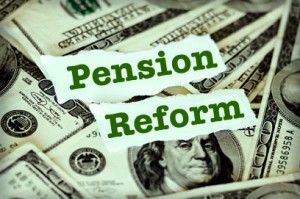CA pension plans prompting tough tradeoffs
by James Poulos | June 4, 2015 5:13 am
 [1]Despite a sounder economic footing, California’s pensions problem has deepened. That was the conclusion drawn by analysts who warned that new accounting rules would shine a startling spotlight on practices long kept in the shadows.
[1]Despite a sounder economic footing, California’s pensions problem has deepened. That was the conclusion drawn by analysts who warned that new accounting rules would shine a startling spotlight on practices long kept in the shadows.
“The Governmental Accounting Standards Board is implementing new rules that require governments, for the first time, to report unfunded pension liabilities on their 2015 balance sheets,” Lawrence McQuillan noted[2] at the Sacramento Bee. “Overall from 2008 through 2012, California local governments’ pension spending increased 17 percent while tax revenue grew only 4 percent.”
County by county
Critics have pointed to evidence of a pattern of conduct in masking pension costs. As Steven Greenhut has observed[3], a grand jury investigation into Marin County pension practices produced a recently issued report with damning details:
“The county’s governments increased pension benefits 38 times between 2001 and 2006. Each time, agencies were supposed to provide public notice about the proposed changes, obtain actuarial reports detailing the future costs of the benefit hikes, and detail the degree to which the increases will affect the funds’ financial conditions.”
Instead, officials “violated these requirements in a variety of ways — providing little, if any, notice to the citizens of Marin County that they would be responsible in the future for hundreds of millions of dollars in pension costs,” the report concluded[4].
In nearby Sonoma County, where roads have fallen into disrepair, residents were recently hit with a 25-cent increase in the sales tax. “California has the highest gas taxes in the nation, a portion of whose revenues is specifically dedicated to local transportation. Yet Sonoma estimates that it needs to spend nearly $1 billion over the next two decades to keep its roads in shape,” the Wall Street Journal reported[5]. The reason for the budget imbalance, the Journal noted, was pension costs:
“Retirement-benefit costs for its public employees are skyrocketing. Between 2005 and 2014, Sonoma’s annual required pension contribution more than doubled, to $52 million, while tax revenues increased 25 percent, to $247 million. Thanks to state balanced-budget requirements, something had to give. In Sonoma it was basic infrastructure.”
As other county-level developments confirmed, budgets have often been locked into producing runaway pension increases. An Orange County Register study revealed[6] that the Orange County Employees Retirement System discovered dozens of fresh retirees whose first-time pension checks neared or exceeded what’s known as their “final average salaries.” But in an email to the Register, OCERS’ deputy chief counsel, David Lantzer, warned that upward adjustments in pension amounts “are statutorily required and may increase retirement benefits to more than 100 percent of a member’s final average salary.”
Broad consequences
As David Crane noted[7] in a critical analysis at Capitol Weekly, county level practices have fostered a statewide problem that has long festered at the level of statewide regulation. “U.S. public pension fund officials get to choose how to account for public pension promises,” he noted. So as the economic picture began to sour in the mid-2000s, California officials used accounting measures to downplay “the reported size of liabilities created by pension promises” so as “to claim that the future costs created by the promises will be smaller than they really will be.” Even though California’s fiscal and economic position has otherwise rebounded, “the more that liabilities were suppressed by aggressive accounting in the past, the greater the rebound effect in the future.”
Marin County’s misleading increases mirrored those long underway in Sacramento, Crane and Greenhut alleged, when in 1999 state legislators retroactively hiked[8] pensions for the California Highway Patrol. That move helped touch off the wave of consequential public pension increases later masked by accounting choices.
Amid the big new outlays planned in Gov. Jerry Brown’s budget, the increasing pressure added by pensions could upset what the governor has hoped is a delicate but dependable balance. “At the end of 2015 the rainy day fund will have a meager $3.5 billion, and the Governor cautions that the ‘budget remains precariously balanced and faces the prospect of deficits in succeeding years.’ Last year the state Legislative Analyst’s Office warned that a modest dip in income growth could trigger multibillion-dollar deficits due to built-in spending increases,” according[9] to the Journal.
- [Image]: http://calwatchdog.com/wp-content/uploads/2014/02/pension_reform_money.jpeg
- noted: http://www.sacbee.com/opinion/op-ed/soapbox/article22543125.html
- observed: http://www.utsandiego.com/news/2015/may/27/pension-grand-jury-capitol-legislators-marin/
- concluded: http://www.marincounty.org/~/media/files/departments/gj/reports-responses/2014/pensionsreport.pdf?la=en
- reported: http://www.wsj.com/articles/public-pension-potholes-in-wine-country-paradise-1432938362
- revealed: http://www.ocregister.com/articles/pension-663707-pay-final.html
- noted: http://capitolweekly.net/stock-market-soars-public-pension-costs/
- hiked: http://calpensions.com/category/calpers/sb-400/
- according: http://www.wsj.com/articles/california-party-time-1433109455
Source URL: https://calwatchdog.com/2015/06/04/ca-pension-plans-prompting-tough-tradeoffs/